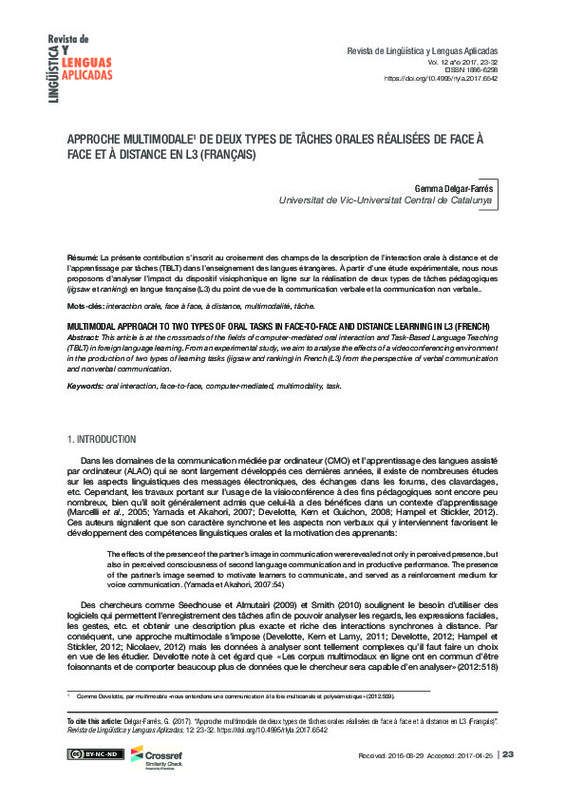Chun, D., Kern, R., & Smith, B. (2016). Technology in Language Use, Language Teaching, and Language Learning. The Modern Language Journal, 100(S1), 64-80. doi:10.1111/modl.12302
Cosnier, J. et Brossard, A. (1984). La communication non verbale : co-texte ou contexte ? In : J. Cosnier et A. Brossard (éds.), La communication non verbale. Neuchâtel : Delachaux et Niestlé, 1-29.
Cosnier, J. et Develotte, C. (2011). Le face à face en ligne, approche éthologique. In : C. Develotte, R. Kern et M.-N. Lamy (éds.), Décrire la conversation en ligne. Le face à face distanciel. Lyon : ENS Éditions, 27-50.
[+]
Chun, D., Kern, R., & Smith, B. (2016). Technology in Language Use, Language Teaching, and Language Learning. The Modern Language Journal, 100(S1), 64-80. doi:10.1111/modl.12302
Cosnier, J. et Brossard, A. (1984). La communication non verbale : co-texte ou contexte ? In : J. Cosnier et A. Brossard (éds.), La communication non verbale. Neuchâtel : Delachaux et Niestlé, 1-29.
Cosnier, J. et Develotte, C. (2011). Le face à face en ligne, approche éthologique. In : C. Develotte, R. Kern et M.-N. Lamy (éds.), Décrire la conversation en ligne. Le face à face distanciel. Lyon : ENS Éditions, 27-50.
Delgar Farrés, G. (2015). L'interaction orale en présentiel et à distance : une étude de cas en classe de français. Synergies Espagne, 8, 111-122.
Develotte, C., Guichon, N., & Kern, R. (2008). «Allo Berkeley ? Ici Lyon… Vous nous voyez bien ?» Étude d’un dispositif de formation en ligne synchrone franco-américain à travers les discours de ses usagers. Alsic, (Vol. 11, n° 2). doi:10.4000/alsic.892
Develotte, C., Kern, R. et Lamy, M.-N. (2011). Décrire la conversation en ligne. Le face à face distanciel. Lyon : ENS Éditions.
Develotte, C. (2012). L’analyse des corpus multimodaux en ligne : état des lieux et perspectives. SHS Web of Conferences, 1, 509-525. doi:10.1051/shsconf/20120100213
Eckerth, J. (2003). Fremdsprachenerwerb in aufgabenbasierten Interaktionen. Tübingen : Narr.
Ellis, R. (2003). Task-based Language Learning and Teaching. Oxford : University Press.
González-Lloret, M. et Ortega, L. (2014). Technology-mediated TBLT. Researching Technology and Tasks. Amsterdam/Philadelphia : John Benjamins Publishing Company.
HAMPEL, R. (2006). Rethinking task design for the digital age: A framework for language teaching and learning in a synchronous online environment. ReCALL, 18(01), 105. doi:10.1017/s0958344006000711
Hampel, R., & Stickler, U. (2012). The use of videoconferencing to support multimodal interaction in an online language classroom. ReCALL, 24(2), 116-137. doi:10.1017/s095834401200002x
Keim, L. et Tortadès, À. (2015). Comparación de la interacción oral de estudiantes de alemán L3 presenciales y online en una tarea de aula. RIED. Revista Iberoamericana de Educación a Distancia, 18/2, 325-353.
Kerbrat-Orecchioni, C. (2011). Conversations en présentiel et conversations en ligne : bilan comparatif. In : C. Develotte, R. Kern et M.-N. Lamy (éds.), Décrire la conversation en ligne. Le face à face distanciel. Lyon : ENS Éditions, 173-195.
Kern, R. (2014). Technology asPharmakon: The Promise and Perils of the Internet for Foreign Language Education. The Modern Language Journal, 98(1), 340-357. doi:10.1111/j.1540-4781.2014.12065.x
Lai, C., & Li, G. (2011). Technology and Task-Based Language Teaching: A Critical Review. CALICO Journal, 28(2), 498-521. doi:10.11139/cj.28.2.498-521
Long, M. H. (1985). A role for instruction in second language acquisition: Task-based language training. In: K. Hyltenstam et M. Pienemann (éds.), Modelling and assessing second language acquisition. Clevedon : Multilingual Matters.
Marcelli, A., Gaveau, D., & Tokiwa, R. (2005). Utilisation de la visioconférence dans un programme de FLE : tâches communicatives et interactions orales. Alsic, (Vol. 8, n° 3). doi:10.4000/alsic.354
Pica, T., Kanagy, R. et Falodun, J. (1993). Choosing and Using Communication Tasks for Second Language Instruction and Research. In : G. Crookes et S. Gass (éds.), Tasks and Language Learning. Integrating Theory and Practice. Clevedon : Multilingual Matters, 9-34.
Robinson, P. (2005). Cognitive Complexity and Task Sequencing: Studies in a Componential Framework for Second Language Task Design. IRAL - International Review of Applied Linguistics in Language Teaching, 43(1), 1-32. doi:10.1515/iral.2005.43.1.1
Robinson, P. (Ed.). (2011). Second Language Task Complexity. Task-Based Language Teaching. doi:10.1075/tblt.2
Rubio, F., Thoms, J. J. (2012). AAUSC 2012 Volume - Issues in Language Program Direction. Hybrid Language Teaching and Learning: Exploring Theoretical, Pedagogical and Curricular Issues. Boston : Cengage Learning.
Samuda, V., & Bygate, M. (2008). Tasks in Second Language Learning. doi:10.1057/9780230596429
Sauro, S. (2009). Strategic Use of Modality during Synchronous CMC. CALICO Journal, 27(1), 101-117. doi:10.11139/cj.27.1.101-117
Seedhouse, P., & Almutairi, S. (2009). A holistic approach to task-based interaction. International Journal of Applied Linguistics, 19(3), 311-338. doi:10.1111/j.1473-4192.2009.00243.x
Smith, B. (2003). Computer?Mediated Negotiated Interaction: An Expanded Model. The Modern Language Journal, 87(1), 38-57. doi:10.1111/1540-4781.00177
Smith, B. (2004). COMPUTER-MEDIATED NEGOTIATED INTERACTION AND LEXICAL ACQUISITION. Studies in Second Language Acquisition, 26(03). doi:10.1017/s027226310426301x
Smith, B. (2010). Employing Eye-Tracking Technology in Researching the Effectiveness of Recasts in CMC. Directions and Prospects for Educational Linguistics, 79-97. doi:10.1007/978-90-481-9136-9_6
Stockwell, G. (2010). Effects of multimodality in computer-mediated communication tasks. In : M. Thomas et H. Reinders (éds.), Task-based language teaching and technology. Londres : Continuum, 83-104.
Yamada, M., & Akahori, K. (2007). Social presence in synchronous CMC-based language learning: How does it affect the productive performance and consciousness of learning objectives? Computer Assisted Language Learning, 20(1), 37-65. doi:10.1080/09588220601118503
Yanguas, I. (2010). Oral computer-mediated interaction between L2 learners: it's about time! Language Learning & Technology, 14/3, 72-93.
[-]








